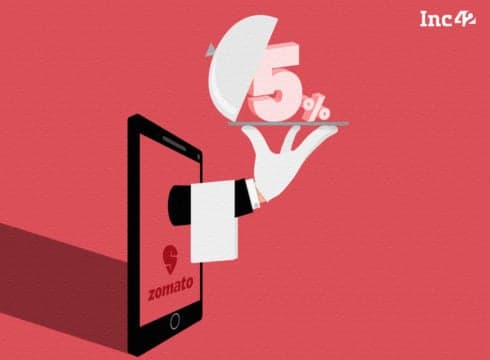Food aggregator apps such as Zomato and Swiggy will collect the tax at the final point of delivery and will pay 5% GST on restaurant services, according to the Goods and Services Tax (GST) council
Instead of collecting GST from restaurants, food aggregators will collect it (5% GST) directly from the customers at the point of delivery and there won't be much difference in the customers’ bills
The new changes would come into effect from January 1, 2022, giving the players time to make changes in their software and adapt to the new regulation
Inc42 Daily Brief
Stay Ahead With Daily News & Analysis on India’s Tech & Startup Economy
In a big relief to restaurants, the Goods and Services Tax (GST) council has decided that food aggregator apps such as Zomato and Swiggy will collect the tax at the final point of delivery and will pay GST on restaurant services. This implies that Zomato, Swiggy and other food aggregators will be liable to pay the 5% GST rate, collected from the customers.
Inc42 had previously reported that the GST council believed food aggregators should be classified as e-commerce operators and pay GST on behalf of the restaurants concerned. Further, the new changes would come into effect from January 1, 2022, giving the players time to make changes in their software and adapt to the new regulation.
“There is no new tax,” revenue secretary Tarun Bajaj said in a statement. “Suppose you order food from the aggregator. Now, the restaurant is paying taxes, but we found some restaurants were not paying [taxes]. We are now saying that if you order, the aggregator will collect from the consumer and pay to the authorities instead of the restaurant doing this.”
No Change In Customer’s Bill
Currently, the chain of GST payments while ordering food online is that the restaurants charge 5% GST on food bills and the food aggregators charge an 18% GST commission from restaurants for delivery and marketing. All of the taxes are eventually included in the customer’s bill. Restaurants collect the GST (18% commission + 5% food GST) and pay it to the government.
The current reform proposes that instead of collecting the GST from restaurants, food aggregators will collect it (5% GST) directly from the customers at the point of delivery — thus if the reform goes as planned, there won’t be much difference in the customers’ bills.
To put it simply, only the burden of tax payment is being shifted from restaurants to food aggregators such as Zomato and Swiggy.
Some Addressable Concerns
Currently, the GST Council classifies food aggregators as Tax Collectors at Source (TCS). According to reports, the reform will classify them as restaurant services, which may invite a uniform tax slab of 5%.
On the other hand, different food items would invite different tax slabs and it will only be clear how the GST council imposes tax collection — uniform 5% rate or 5% + 18% or different slabs for different foods — when the government releases detailed circulars/notifications/law amendments in the coming days.
{{#name}}{{name}}{{/name}}{{^name}}-{{/name}}
{{#description}}{{description}}...{{/description}}{{^description}}-{{/description}}
Note: We at Inc42 take our ethics very seriously. More information about it can be found here.


